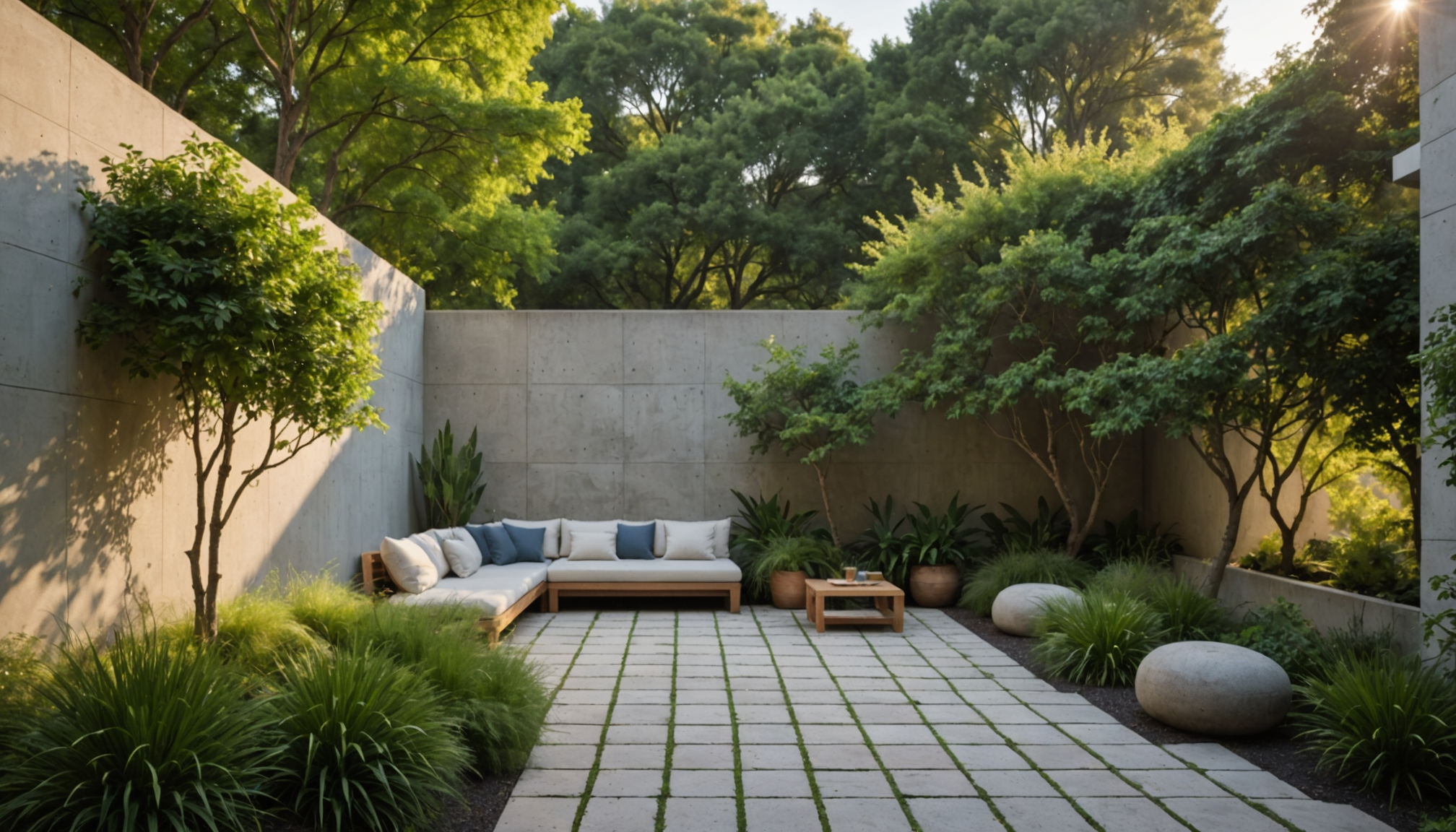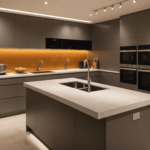When it comes to soundproofing your patio, understanding the different types of outdoor noise barriers available is crucial. These barriers are essential in minimizing the infiltration of unwanted noise, creating an oasis of peace and tranquility right outside your windows. Selecting the appropriate noise barrier requires examining their effectiveness and compatibility with your existing outdoor space and lifestyle.
Solid Barriers: Solid barriers, such as concrete walls or brick partitions, are highly effective in blocking outdoor noise. Their dense materials prevent sound waves from passing through, making them one of the best soundproofing solutions for patios. However, these structures can be quite imposing and may not complement every aesthetic or landscape design.
Wooden Fences: A popular choice for many homeowners, wooden fences can serve as both a visual and sound barrier. When constructed with overlapping panels or layers, these fences can reduce noise significantly. To enhance their soundproofing abilities, consider adding a sealant or mass-loaded vinyl to fill the gaps. This not only improves their acoustic performance but also extends their durability throughout various seasonal changes.
Corrugated Metal Panels: Corrugated metal panels offer a sleek, modern alternative to traditional patio barriers. These structures are easy to install and maintain, though they may require additional layering or materials to effectively dampen noise. They are an excellent choice for those looking to implement a DIY solution, as they can be styled and adjusted according to individual design preferences.
The table below provides a comparative overview of the different types of outdoor noise barriers, focusing on key attributes such as cost, effectiveness, and aesthetic appeal:
| Barrier Type | Cost | Effectiveness | Aesthetic Appeal |
| Solid Barriers (Concrete/Brick) | High | Very High | Varies |
| Wooden Fences | Moderate | High | High |
| Corrugated Metal Panels | Moderate | Moderate | Moderate |
Ultimately, the best barrier will align with your budget, noise reduction requirements, and stylistic preferences. When selecting, be mindful to consider how the barrier will integrate with your patio’s existing layout and whether it will complement or detract from the overall ambiance you wish to create. By choosing the right noise barrier, you can transform your outdoor space into a private retreat, free from the disturbances of the surrounding environment.
Choosing materials for soundproofing
To effectively soundproof your patio, selecting the right materials is just as crucial as choosing the type of barriers. The goal is to find materials that not only block or absorb sound but also withstand various weather conditions while enhancing the aesthetic appeal of your outdoor space. Here’s how you can choose the best materials for your soundproofing needs:
1. Assess Environmental Conditions:
– Before choosing materials, consider the climate and seasonal changes in your area. Materials that can withstand rain, wind, and sun while retaining their soundproof qualities are essential.
– Look for materials with high durability ratings to ensure they maintain their effectiveness year-round.
2. Evaluate Material Density and Thickness:
– The thicker and denser the material, the better it will be at reducing noise. Materials such as mass-loaded vinyl (MLV) are excellent choices due to their density and flexibility.
– Consider layering materials to increase their sound blocking capabilities. For instance, combining MLV with a wooden structure can reduce noise transmission effectively.
3. Consider Aesthetic and Budgetary Constraints:
– Select materials that align with the desired look of your patio. Materials like composite wood can mimic natural wood’s appearance while offering superior durability and noise reduction.
– Set a budget for your project and choose materials that offer the best compromise between cost and soundproofing efficiency. Sometimes, middle-range materials can provide a good balance between aesthetics and functionality.
4. Prioritize Ease of Installation:
– Choose materials that are easy to install, especially if you’re considering a DIY approach. Options like acoustic panels and soundproofing blankets can often be installed with minimal tools and expertise.
– Ensure the materials you select come with clear installation instructions or consider hiring a professional for more complex setups.
5. Ensure Compatibility with Current Structures:
– Check if your selected materials can be easily integrated with existing patio structures such as fences or walls. Compatibility can reduce the time and cost involved in customizing the space for soundproofing purposes.
– Ensure you have a plan to address any gaps or edges where sound might leak, as these can undermine the effectiveness of your soundproofing efforts.
6. Focus on Longevity and Maintenance:
– Opt for materials that offer low maintenance needs without compromising on soundproofing efficiency. Weather-resistant materials that can handle outdoor exposure are ideal.
– Initially investing in high-quality materials may reduce the need for frequent replacements or repairs, saving money in the long run.
By carefully assessing these factors, you can choose materials that not only enhance the tranquility of your outdoor retreat but also fit seamlessly with your existing patio design and personal preferences. Whether you aim for a DIY project or decide to bring in professional help, selecting suitable soundproofing materials is a key step towards constructing a peaceful and enjoyable patio environment adjacent to your home windows.
Plant-based sound reduction solutions
Transforming your patio into a tranquil outdoor retreat can be effortlessly achieved by incorporating plant-based solutions to reduce sound. This approach not only offers eco-friendly benefits but also enriches the aesthetic appeal of your patio. Plants serve as a natural buffer against noise by dispersing sound waves and offering a serene backdrop to any outdoor setting.
One of the most effective ways to use greenery for sound reduction is by planting dense hedges and trees. Species like arborvitae or privet are particularly suitable for this purpose due to their thick foliage and rapid growth. These green barriers can significantly decrease the noise coming from nearby roads or bustling neighborhoods by absorbing and refracting sound waves. Strategically positioning these plants around the perimeter of your patio can create a natural soundproof boundary.
Vertical gardens or green walls provide another innovative solution for sound management. These structures involve covering walls or fences with climbing plants or attaching planter boxes in a vertical configuration. As the vegetation matures, it forms a lush living wall that not only contributes to reducing noise but also improves air quality and adds vibrancy to your space. Furthermore, these installations can be maintained year-round with minimal effort, making them an attractive option for homeowners seeking a low-maintenance soundproofing method.
Incorporating plant beds filled with densely growing ground covers and shrubs adds another layer of sound absorption. Selecting plants like ferns, hostas, or ornamental grasses can be particularly effective. These species with broad, layered leaves help scatter sound and create a calm, auditory environment amidst your garden. Additionally, they thrive in various climatic conditions, providing seasonal interest and a burst of greenery as the seasons change.
It’s crucial to consider the specific conditions of your patio when choosing plant-based sound reduction solutions. Factors such as the amount of sunlight, soil quality, and the local climate will influence the plant varieties that will flourish in your space. Consulting with a local nursery or gardening expert can guide you in selecting the most suitable species for your area. Incorporating a mix of evergreens and deciduous plants ensures year-round coverage and ensures that your patio remains soundproof through different weather conditions.
Moreover, the integration of water features like fountains or small ponds can complement plant-based soundproofing efforts. The gentle sound of trickling water not only masks unwanted noise but adds a calming auditory element that elevates the overall ambiance. When paired with lush vegetation, these features create an oasis of calm and enhance the natural beauty of your outdoor sanctuary.
In conclusion, plant-based sound reduction solutions offer an eco-friendly and visually appealing method to enhance your patio’s tranquility. Through the strategic use of hedges, vertical gardens, and diverse plant beds, along with supplementary features like water elements, you can cultivate a luxurious, peaceful retreat just outside your windows. By harnessing the power of nature, you not only contribute to environmental wellness but also create an inviting haven where you can relax and unwind.
Installing acoustic panels and fences
To effectively mitigate noise on your patio, installing acoustic panels and fences is a practical solution that can significantly enhance the serenity of your outdoor space. These elements not only block chatter and traffic sounds but also add an aesthetic layer to your patio design, turning it into a personal haven adjacent to your home windows.
Acoustic panels are specially designed to absorb sound and reduce echo, making them an excellent choice for minimizing noise on your patio. These panels can be crafted from materials like foam, fiberglass, or fabric and are typically installed along walls or fences to capture and dissipate sound waves before they reach your sitting area. Modern acoustic panels come in various styles and colors, allowing you to customize the look to seamlessly blend with your patio décor. When installing these panels, ensure they are securely mounted and evenly spaced to maximize their sound-absorbing properties.
Fences offer another effective method for soundproofing. Opting for specially designed acoustic or sound barrier fences can make a noticeable difference in creating a quieter outdoor environment. These fences are usually constructed with dense materials that interrupt the path of sound waves, thereby reducing noise permeation. Materials like wood, vinyl, or composite elements are often used to build these barriers, ensuring both durability and minimal maintenance needs. For even greater sound reduction, consider adding a layer of mass-loaded vinyl to the interior of the fence. This layer of dense material enhances the fence’s ability to block sound, particularly in areas exposed to high noise levels.
For a more DIY approach, transforming a standard fence into a soundproof one could involve several creative tricks. Start by ensuring there are no gaps or spaces between the panels, as these could allow noise to penetrate. Adding additional layers, such as sound-blocking fabric or weather-resistant blankets, can further enhance noise reduction without requiring extensive reconstruction. These layers not only serve as extra sound barriers but also contribute to the seasonal versatility of your patio. Choose materials that are resilient to weather changes to maintain effectiveness throughout the year.
Additionally, combining acoustic panels with fences can double the effectiveness of your soundproofing efforts. Installing panels on the interior side of a fence adds a professional touch, creating a double-layer barrier that combats noise on two fronts. This technique is particularly useful for properties located near busy roads or urban areas where ambient noise is a constant concern.
When planning the installation, it’s crucial to consider the layout of your patio. The positioning of panels and fences should create a cohesive look that integrates into your existing setup while optimizing sound reduction. By focusing on strategic placement, you not only enhance their effectiveness but also maintain the aesthetic appeal of your outdoor space.
In crafting your peaceful patio with this soundproofing approach, you encourage more enjoyable outdoor experiences and a tranquil environment conducive to relaxation and leisure. Remember to periodically assess the condition of your installations, ensuring they continue to meet your soundproofing needs and evolve with your lifestyle. Through thoughtful, well-planned installations, your patio can transform into an oasis of calm, allowing you to unwind and escape the hustle and bustle of everyday life.
Creative DIY soundproofing methods
When it comes to devising creative DIY methods for soundproofing your patio, there are a plethora of innovative techniques that can make a significant difference without the need for professional intervention. These methods leverage common materials and ingenious strategies to create a more serene outdoor environment, allowing you to enjoy your patio in peace, away from the disturbances outside your windows.
Consider starting with sound-absorbing textiles, such as heavy-duty, weather-resistant curtains or outdoor soundproofing blankets. These materials can be hung around your patio to create a flexible barrier against noise. They not only diminish sound but also serve as a stylish addition, providing shade and an element of privacy during daylight hours. Opt for thick, high-density fabrics that can withstand seasonal weather changes to ensure longevity and efficiency.
Another approachable DIY strategy is using recycled materials, such as old pallets, to construct a customized sound barrier wall. This involves assembling a series of pallets vertically side by side along the perimeter of your patio. By filling the gaps with foam or a similar sound-absorbing material, you create a rustic and effective soundproof barrier. Painting or staining the pallets can enhance their visual appeal, seamlessly integrating them with your patio’s aesthetic. This innovative approach not only recycles materials but adds a personalized touch to your outdoor space.
Moreover, think about utilizing large, strategically placed planters filled with plush vegetation as sound barriers. These planters can be filled with dense shrubs or evergreen species to form a natural barricade. Arranging them in a staggered pattern around your patio can help disrupt and absorb noise, turning your patio into a peaceful enclave. This method is both cost-effective and eco-friendly, providing seasonal beauty that complements your outdoor environment.
For a more tech-savvy DIY approach, explore the possibility of integrating white noise machines or strategically positioning Bluetooth speakers that play ambient sounds or calming music. When positioned cleverly, these devices can mask unwanted noise and transform your patio into a sanctuary of calm, making urban life feel a world away. Ensure these devices are weatherproof and have a good sound range to suit the open environment of your patio.
Finally, consider enhancing your patio with creative landscaping structures, like trellises or pergolas, adorned with vines or climbing plants. These structures act as sound-baffling frameworks, diffusing sound waves while adding a charming and refreshing element to your outdoor space. By incorporating seasonal flowering plants, you can also introduce a touch of color and fragrance during different times of the year.
Each of these creative methods requires a modest investment of time and resources yet yields substantial rewards in creating a relaxing, noise-controlled patio environment. Embrace the challenge of transforming everyday materials into soundproof solutions, ensuring an inviting and tranquil haven just outside your windows.
In conclusion, soundproofing your patio is both an art and a science, integrating practical solutions with creative flair to craft a serene outdoor oasis. By understanding various noise barriers, selecting appropriate materials, incorporating plant-based solutions, installing acoustic panels, and exploring DIY methods, you can effectively reduce external noise and extend your indoor comfort to your outdoor living area. Whether you opt for simple modifications or elaborate installations, the transformation of your patio will not only enhance your leisure time but also add significant value and charm to your home.


